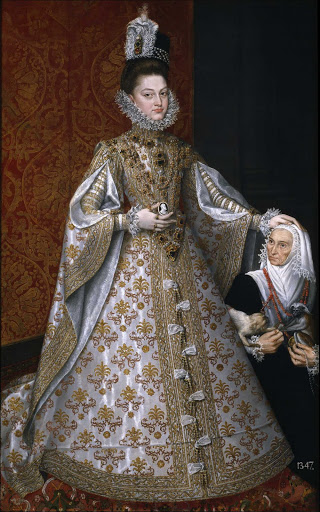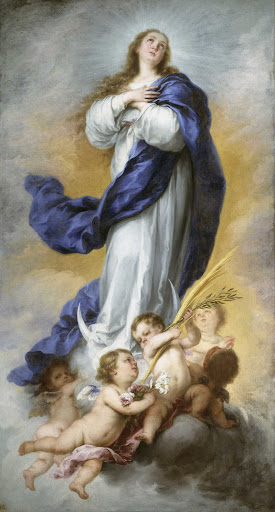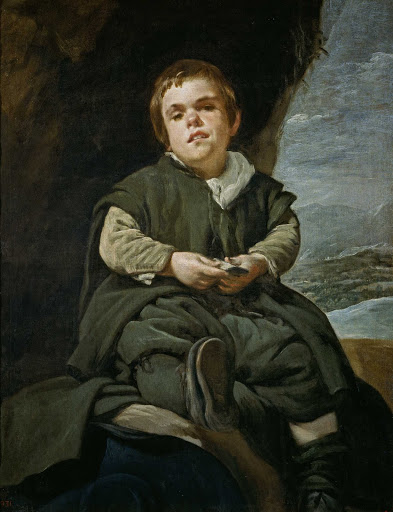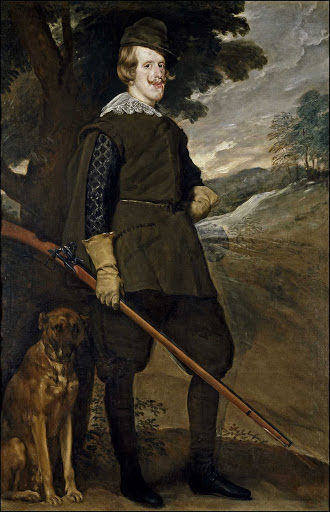In keeping with its founding mission of making great artworks accessible to the general public, the Museo Nacional del Prado in Madrid has chosen the Museum of Fine Arts, Houston for an exclusive, groundbreaking exhibit.

Alonso Sánchez Coello - the Infanta Isabel Clara Eugenia
“The history of Spanish painting is that paintings were acquired by and belonged to the royal families. So the public did not have access to them. When the Prado museum was founded, access by the public became its vocation. That mission has been at the forefront throughout its 200-year history, said Javier Portús, chief curator of Spanish painting through the 1700s at the Prado museum.
The exhibit, “Portrait of Spain: Masterpieces from the Prado,” spans four centuries of Spanish painting from the 16th to the 20th century. It consists of more than 100 artworks from iconic Spanish artists such as Goya, Velazquez, Murillo, El Greco, Ribera, and Sorolla. Works by European artists who influenced Spanish painting include those of Titian, Tiepolo, and Rubens.
Formally inaugurated during the reign of Ferdinand VII in November 1819, the Prado Museum is home to more than 5,000 works of art, including 2,300 paintings. The museum is also a treasure trove of sculpture, prints, and other artworks.
The blockbuster exhibit opens at the MFAH December 16 and runs through March 31, 2013 in the museum’s Audrey Jones Beck building. The general public may begin purchasing tickets in advance of the exhibit on October 29.
Through the artworks of the old masters, visitors will learn about the whole spectrum of Spain’s art and history, including its royal monarchs, wars, invasions, daily life, and religious legacy. As in other landmark exhibits held at the MFAH, this exhibit will be structured along timed admission tickets.

Bartolomé Esteban Murillo - the Immaculate Conception
The MFAH is the only U.S. venue for “Portrait of Spain: Masterpieces from the Prado” exhibit, which began its journey this summer at the Queensland Art Gallery in Brisbane. This is also the first time the Prado has loaned so many works from its European collection to an American museum.
Portús said a serendipitous encounter in Brisbane with Gary Tinterow, then head of New York Metropolitan Museum of Art department of modern and contemporary art, evolved and culminated with the Texas exhibit after Tinterow was named MFAH director.
“We traveled to Australia to present our project on taking the Prado’s masterworks to Brisbane. Gary Tinterow, the Museum of Fine Arts Houston director, also had traveled to Brisbane to speak. That’s where he learned about our project. When he became director of the Houston museum last year, he expressed interest in having it come there,” said Portús, from his museum office in Madrid.
Tinterow, who joined the MFAH in January 2012 after 28 years at the Met, said in a video clip message to patrons that the Prado exhibit is in keeping with his goal of making the MFAH more open and reflective of the interests of a diverse community.
“On the one hand, I hope our institution, our museum, our galleries will reflect the interests and diversity of the community. At the same time, our primary responsibility is to educate the community, not just hold up a mirror and show them what they already know,” Tinterow said.

Diego Velázquez, Francisco Lezcano - The Boy from Vallecas
The museum’s responsibility is “to expose them to new ideas, new cultures and new works of art that sit them back on their heels and make them think twice,” said Tinterow, who began the video by reminding viewers that the face of America has changed since the MFAH’s founding in 1924.
According to the New York Times, Tinterow spearheaded efforts to bring several blockbuster exhibits to the Met during his nearly 30-year tenure. So the Prado exhibit may represent a glimpse into MFAH’s exciting new future.
The “Immaculate Conception” by Bartolome Esteban Murillo, the “Descanso de Marte” (Resting Mars) by Diego Velazquez and Francisco de Goya’s “El Cacharero” (Pottery Vendor) are three of the stellar paintings included in “Portrait of Spain: Masterpieces from the Prado” exhibit at the MFAH.

Crockery Vendor by Spanish artist Francisco de Goya
Visitors begin their journey through Spain’s artistic evolution with a look at its Golden Age, 1550 to 1770. This period in Spanish history was dominated by the Habsburg and Bourbon dynasties. The first section, “Painting in an Absolute State,” exemplifies the seminal works of Diego Velazquez, Francisco de Zurbaran, and El Greco, whose works reflect the Enlightenment epoch.
“This exhibit will be installed under three distinct eras of Spanish painting. The first is 1550 to 1770. Painting in an absolute state highlights royal portraits, royal activities, kings and buffoons. It also highlights religious painting. There were several important artists in this time period, notably El Greco,” said Edgar Peters Bowron, MFAH Audrey Jones Beck curator of European Art.

Diego Rodríguez de Silva y Velázquez - King Phillip in Hunting Garb
The second section of the exhibit is from 1770 to 1850 and titled “A Changing World.” Artists illustrate the impact of Napoleon’s invasion of Spain and the ensuing decades of civil war. Despite the chaotic times-or perhaps because of them-Spain produced several well-known artists.
Francisco de Goya y Lucientes was the preeminent artist of this time period for two monarchs, Charles IV and later on, his son Fernando VII. Goya’s work in the exhibit is represented by Neoclassical portraits, including those of Manuel Silvela and Marchioness Villafranca.
As Goya matured, he contracted a mysterious illness that led to hearing loss. His ailing health, family loss, and war memories inspired three series of dark artworks: Los Caprichos (the whims), Los Disparates (foolish quips), and Los Desastres de la Guerra (the disasters of war) along with other works.
“I think another highlight of the exhibition are the 20-plus prints by Goya, such as Los Caprichos, Los Disparates, and Los Desastres de la Guerra, which reflect the disaster of war. That’s a wonderful series and introduction to the late 18th century and early 19th century Spain,” said Bowron.
The third and final section is from 1850 to 1900 and titled “The Threshold of Modern Spain.” It focuses on the emergence of Spain’s national identity and Spain’s economic prosperity. The mid-19th century was a time when artists embraced Romanticism. Their artworks include landscapes, portraits, historical and religious scenes, and nudes.
The final section features the works of Federico de Madrazo. One-time director of the Prado Museum, Madrazo was known for portraits and historic paintings. Other noteworthy painters in the final section include Eduardo Rosales, Mariano Fortuny, and Aureliano de Beruete, one of the earliest Spanish painters to identify with Impressionism.
Another distinguished artist to be featured in the final section is Joaquin Sorolla, who emerged as one of Spain’s most outstanding Realist and Impressionist painters. His use of sunlight and shadow in paintings of the Valencia seashore, fishermen and farmers helped propel Spain into modernity.
While this is the second time that the Lone Star State will be honored with an exhibit from the Prado Museum, the MFAH exhibit contains the largest number of masterworks ever loaned to any U.S. museum, Portús said.
“In the 1960s, we had an exhibit in San Antonio. But that was a smaller exhibit. In this exhibit, more than 40 major Spanish masters will be represented. Additionally, many artists from Italy and other European countries who contributed to Spain’s artistic heritage will be represented,” he said.
Devotees of Spanish painting may want to prepare for the Prado exhibit by visiting the Meadows Museum in Dallas. In September, “Diego Velazquez: The Early Court Portraits” exhibit opened. It will continue through January 13, 2013. While the Meadows and MFAH exhibits coincide, they are totally independent projects.
“The celebration of Velazquez by the Meadows Museum at almost the same time as the Prado exhibit opens in Houston is a coincidence, although we were working on both projects simultaneously. But the fact that both exhibits are ongoing in Texas is not a coincidence, Portús said.
“The fact that the Meadows Museum has the largest collection of Spanish art outside of Spain is one reason. Another reason is that the abundant Hispanic population has made Texas a magnet for Spanish art,” he said.
BBVA Group, headquartered in Madrid and part of BBVA Compass Bank, is a major sponsor of the Prado exhibit at MFAH. The Hamill Foundation provided the lead underwriting for the exhibit.
To purchase tickets starting on Oct. 29 or obtain more information on the Prado exhibit, please visit www.mfah.org or call (713) 639-7300. For more information on the Meadows Museum visit the web site at www.meadowsmuseum.org
Rosie Carbo is the Lifestyles Editor for Wandering Educators
Alonso Sánchez Coello, The Infanta Isabel Clara Eugenia (1566–1633) and Magdalena Ruiz, c. 1585–88, oil on canvas, Museo Nacional del Prado, Madrid. © Photographic Archive, Museo Nacional del Prado, Madrid
Bartolomé Esteban Murillo, The Immaculate Conception of Aranjuez, 1670–80, oil on canvas, Museo Nacional del Prado, Madrid. © Photographic Archive, Museo Nacional del Prado, Madrid
Diego Velázquez, Francisco Lezcano, The Boy from Vallecas, c. 1636-38, oil on canvas, Museo Nacional del Prado, Madrid. © Photographic Archive, Museo Nacional del Prado, Madrid
Francisco de Goya, The Crockery Vendor, 1778-1779, oil on canvas, Museo Nacional del Prado, Madrid. © Photographic Archive, Museo Nacional del Prado, Madrid
Diego Velázquez, King Philip IV (1605–1665) in Hunting Garb, c. 1633, oil on canvas, Museo Nacional del Prado, Madrid. © Photographic Archive, Museo Nacional del Prado, Madrid
